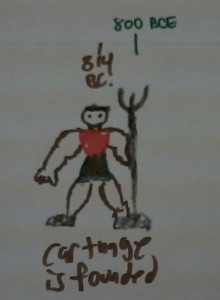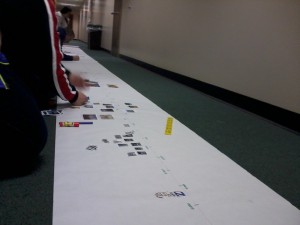
Dating….no, it’s not a lonely-hearts club for archaeologists! This week we covered how archaeologists date sites and artifacts. From the use of stratigraphy and superimposition to provide relative dating, to C-14 and other techniques to assign more specific dates, we covered the basics of “pre-historic” and “historic” as it pertains to the artifacts of the Whispering Woods site. We also talked about dating systems (BCE/CE, BP, & BC/AD).
At Whispering Woods, most of the prehistoric (Native American) artifacts found date from the Middle to Late Woodland period, roughly 0 – 1650 CE. Anything historic is non-Native American and can be dated according to style or technology. For instance, our tin-glazed pottery dates from the late 1600’s – mid 1700’s; our musket ball is around 1860; and then there is plenty of “modern” items such as bottles and cans.
But what do all these dates mean in the broader context of human history and culture? What was going on in Ancient Rome when our native Whispering Woods people were making pottery and projectile points?

To illustrate this, our class mapped out a time line of “human history”, and more importantly, put that timeline to scale. One centimeter equaled 100 years. So 0 – 2015CE was a little more than 6ft long. 5,000BCE – 0 was 15 feet long! Of course human culture goes back much farther – 10,000BCE is the emergence of agriculture – but we were running out of hallway. Each student was assigned a continent or a culture (Greece/Rome, Western Europe before 1600, Western Europe after 1600, the Americas, Asia, the Vikings [Tovah’s personal favorite], Mesopotamia & Egypt, and so on). Students had to bring in 20-30 dates from their assigned culture and plot them, along with a representational image, onto the timeline.
Our students quickly learned that 20-30 dates was a struggle – not to find, but to limit to. Also a struggle was the convergence of so many events in the last 300 years. So much happened in such a small space. Students left with a sense of how events in different cultures overlapped as well as the exponential activity as they approached the present.
Our final project was a 30ft long timeline that was both fun and enlightening to construct. Now, where to hang it??
